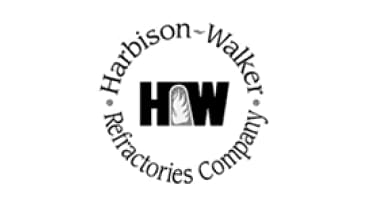Harbison-Walker Refractories Co.
From 1960 to 1981, Harbison-Walker manufactured asbestos-containing rope, brick, refractory cement and other contaminated products that led to asbestos litigation. The company filed for bankruptcy in 2002 and established a trust fund. It contains approximately $1.53 billion to handle future asbestos claims.

Harbison-Walker’s History with Asbestos
The Harbison-Walker Refractories Company was founded in 1865 under the name Star Fire Brick Company. The name changed to Harbison-Walker in 1875.
The company’s primary products included fireproof bricks and other industrial materials that could withstand high temperatures. Because of its fireproofing characteristics, asbestos was used in many Harbison-Walker products.
In 1967, Harbison-Walker merged with Dresser Industries Inc. Harbison-Walker began facing asbestos-related lawsuits in the 1990s, filed by people who developed asbestos-related diseases after using its products.
Dresser merged with energy industry giant Halliburton in 1998 after Dresser agreed to handle all asbestos-related claims stemming from Harbison-Walker products. Halliburton soon realized its involvement in the litigation proceedings was unavoidable.
At the time of Halliburton’s acquisition of Dresser, which included subsidiary Harbison-Walker, former Vice President Dick Cheney was the chief executive officer of Halliburton, according to The New York Times.
The merger was initially considered a positive move on Cheney’s part, but current and future asbestos suits stemming from Harbison-Walker products cost the company a fortune in legal claims. Halliburton said the level of asbestos problems that accompanied the merger couldn’t have been anticipated.
In 1999, Harbison-Walker was purchased by RHI AG, an Austrian company that produces refractory products. After this purchase, Halliburton and Dresser were left to handle all asbestos-related claims involving Harbison-Walker products.
In 2015, the company modified its name to HarbisonWalker International. It is the largest supplier of refractory products and services in the U.S.
Development of the Harbison-Walker Trust
Harbison-Walker entered bankruptcy so it could not only survive, but also reorganize and set up an asbestos trust to handle future asbestos-related claims. Harbison-Walker felt the decision benefitted the company, its stakeholders and asbestos claimants.
The Harbison-Walker bankruptcy case is unusual compared to other asbestos companies that filed for bankruptcy.
Harbison-Walker and its parent company, Dresser Industries Inc., had merged with Halliburton prior to filing for bankruptcy in 2002. During the bankruptcy, the company struck a deal with its insurers, London Underwriters (and their reinsurers, Equitas), to settle the asbestos claims for “100 cents” on the dollar, meaning the full value of the claims.
The trust that resulted from the settlement, known as DII Industries, LLC Asbestos PI Trust, was funded with about $4 billion. Recent estimates show it now contains about $1.65 billion.
As of January 2022, the trust’s payment percentage is 60%, which is high compared to other asbestos trust funds.

Gain access to trust funds, grants and other forms of compensation for you or your loved ones.
Get Help NowAsbestos Litigation Involving Harbison-Walker
Even as the company’s business was growing, the turn of the 21st century greeted Harbison-Walker with more than 200,000 pending mesothelioma claims, of which nearly 132,000 were related to an indemnification agreement made as part of the company’s 1992 spin-off from Dresser.
- Just before Harbison-Walker filed for bankruptcy, a 2001 asbestos verdict of $40 million was awarded to five victims of asbestos-related diseases. The jury found Harbison-Walker, A.P. Green Industries Inc. and Armstrong Contracting and Supply guilty of exposing the victims to asbestos-containing products while knowing the hazards associated with asbestos.
- Other asbestos verdicts issued against Harbison-Walker in 2001 totaled $112 million. These giant losses led the company to consider bankruptcy and reorganization.
Harbison-Walker’s Asbestos Products
Asbestos-containing products manufactured by Harbison-Walker included:
- Asbestos rope
- Castables
- Chromepak G
- H-W Lightweight Castable #10
- Micracrete refractory cement
- Metalkase firebrick
Harbison-Walker manufactured these products between 1960 and 1981. They were used in construction, power generation, rubber manufacturing, chemical production, pulp and paper mills, metal works and aboard U.S. Navy ships.
Harbison-Walker’s Occupations at Risk
The following occupations were at risk of exposure to Harbison-Walker’s asbestos products:
- Harbison-Walker manufacturing plant workers
- Cement workers
- Construction workers
- Foundry workers
- Masonry workers
- Metal workers
- Chemical plant workers
- Refractory plant workers
- Rubber plant workers
- Paper plant workers
- Power plant workers
- Oil refinery workers
- Veterans of the U.S. armed forces
Workers in a variety of industries, including power generation, construction, manufacturing and maritime operations, were exposed to asbestos through Harbison-Walker’s products. U.S. Navy veterans faced the risk of heavy exposure to Harbison-Walker’s asbestos products aboard naval vessels with poor ventilation.
Former employees of Harbison-Walker who worked in manufacturing facilities faced high levels of asbestos exposure and may still be at risk of developing asbestos-related diseases such as lung cancer, asbestosis and mesothelioma.
Recommended Reading


